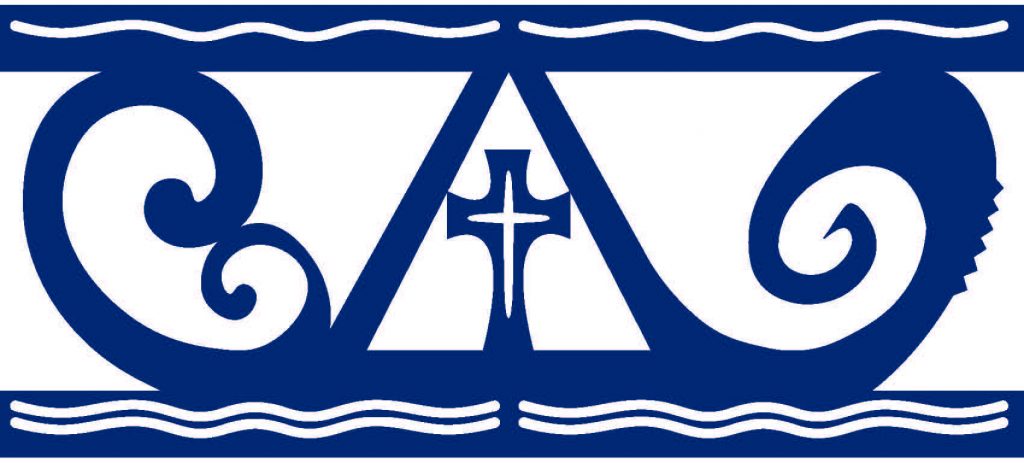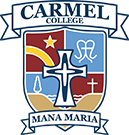Our Kowhaiwhai
Kowhaiwhai patterns, as well as being decorative, reveal many stories.

As partners to Te Tiriti o Waitangi, we name our pepehea and identify with the tradition of the first peoples of Aotearoa New Zealand.
This Kowhaiwhai first tells the Carmel College pepehea –
Ko Rangitoto te maunga
Ko Waitemata te moana
Ko Pupuke te roto
Ko Takapuna te whenua
Ko Carmel te kura
Ko Nga hau e wha te iwi
The mountain is central to the design, as is the calm water at the base of the kowhaiwhai. Reminding us also of Ranginui and Papatuanuku above and below us.
The waters are in two parts as in Maori tradition the meeting of the waters, such as in Aotearoa New Zealand where the Tasman meets the Pacific, are sacred places.
He Waka Eke Noa
This whakatauki (proverb) is about an experiential journey in which everyone may embark upon. This relates to a waka not being owned by one person but was used by all within the whānau and hapu (sub tribe). It also relates to a means of transportation of knowledge, whakapapa, taonga, tikanga, kawa, kai tupuna and tangata (living and dead). The waka is a strong element of the design.
For each individual member of our Carmel community, the waka represents their personal learning journey, with Christ in the waka with them and our collective journey as a Carmel learning community.
The barbs (serrated part of hook) at the front of the waka are wave breakers and help us to be resilient and to push through the difficult times.
Our waka is about each member of our community embarking on a journey of growth, learning and self discovery.
As a Catholic school and through our baptism, we are children of God. Our Catholic faith is central to our beliefs and actions.
Secondly, the kowhaiwhai tells of Christ and his Mother Mary whom our school is named for.
On the left is the infant Jesus, held in the arms of Mary reminding us of the moment of the incarnation.
Central to the design and to our lives is the empty cross reminding us of the centrality of the death and resurrection of Christ to our lives.
Lastly, on the right is a fish hook.
And he said to them, “Follow me, and I will make you fish for people.” Matt 4:19
The invitation to trust in Hehu Karaiti and launch out into the deep, to be disciples, and to encourage others to be disciples.
The central triangular image also reminds us of our Trinitarian belief.
We are a Mercy learning community. Catherine McAuley reminded us that “Mercy is the principal path marked out by Jesus for those who wish to follow him.”
The third dimension of the kowhaiwhai is the Mercy story as it challenges us to hold firm to our five core Mercy values.
The image of the waka tells the story of Cecilia Maher and the early Sisters of Mercy who brought the charism of Mercy to Aotearoa New Zealand.
Whakaute – Respect – The child reminds us that we are made in the image and likeness of God (Gen 1:27) and all have intrinsic human dignity, te tapu o te tangata.
Manaakitanga – Care – The mother holding the child reminds us that we must show care for those who are vulnerable and in need of our help, aroha ki te rawa kore.
Tika – Justice – The mountain is about strength, about holding firm to what is right and seeking tika, justice, for all.
Āwhinatanga – Service – The fish hook is about awhinatanga, service, which includes hospitality. It is about sharing what we have with those in need as well as living sustainably. The hook also represents engagement with student learning and to ‘provide’ sustenance for the people: love, nurture, education, food and opportunity.
Māia – Courage – We see the waters that the women of Mercy sailed on to serve in new lands.
The mountain central to the image symbolises Mt Carmel and the six barbs are for our six houses – Alexandra, Cecilia Maher, Justine, Kelly, McAuley and Pompallier.
Use of the Kowhaiwhai
The kowhaiwhai, when placed end to end, has the waka facing the same direction. This shows that as a Carmel learning community, we travel together and not in separate ways.
A kowhaiwhai should always be at the top of a page as Māori tikanga tells us to “never stand on a kowhaiwhai” as it is part of the story of the community that it represents.
The kowhaiwhai should not be distorted in any way without permission. –
